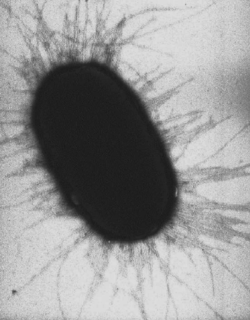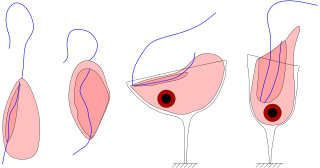Related Research Articles

Gram-positive bacteria are bacteria that give a positive result in the Gram stain test, which is traditionally used to quickly classify bacteria into two broad categories according to their cell wall.

The micrometre or micrometer, also commonly known by the previous name micron, is an SI derived unit of length equalling 1×10−6 metre ; that is, one millionth of a metre.
A human pathogen is a pathogen that causes disease in humans.

Yersinia is a genus of bacteria in the family Yersiniaceae. Yersinia species are Gram-negative, coccobacilli bacteria, a few micrometers long and fractions of a micrometer in diameter, and are facultative anaerobes. Some members of Yersinia are pathogenic in humans; in particular, Y. pestis is the causative agent of the plague. Rodents are the natural reservoirs of Yersinia; less frequently, other mammals serve as the host. Infection may occur either through blood or in an alimentary fashion, occasionally via consumption of food products contaminated with infected urine or feces.

Hormogonia are motile filaments of cells formed by some cyanobacteria in the order Nostocales and Stigonematales. They are formed during asexual reproduction in unicellular, filamentous cyanobacteria, and some may contain heterocysts and akinetes.
Aquifex pyrophilus is a rod-shaped bacterium with a length of 2 to 6 micrometers and a diameter of around half a micrometer. It is one of a handful of species in the Aquificae phylum, an unusual group of thermophilic bacteria that are thought to be some of the oldest species in the bacteria domain.
Mycobacterium phlei is a species of acid-fast bacteria in the genus Mycobacterium. It is characterized as one of the fast-growing mycobacteria. M. phlei has only occasionally been isolated in human infections, and patients infected with M. phlei generally respond well to anti-mycobacterial therapy. M. phlei has an unusually high GC-content of 73%.

Vorticella is a genus of bell-shaped ciliates that have stalks to attach themselves to substrates. The stalks have contractile myonemes, allowing them to pull the cell body against substrates. The formation of the stalk happens after the free-swimming stage.

In bacteriology, a fimbria, also referred to as an "attachment pilus" by some scientists, is an appendage that can be found on many Gram-negative and some Gram-positive bacteria that is thinner and shorter than a flagellum. This appendage ranges from 3–10 nanometers in diameter and can be up to several micrometers long. Fimbriae are used by bacteria to adhere to one another and to adhere to animal cells and some inanimate objects. A bacterium can have as many as 1,000 fimbriae. Fimbriae are only visible with the use of an electron microscope. They may be straight or flexible.
Propionibacterium freudenreichii is a Gram-positive, non-motile bacterium that plays an important role in the creation of Emmental cheese, and to some extent, Jarlsberg cheese, Leerdammer and Maasdam cheese. Its concentration in Swiss-type cheeses is higher than in any other cheese. Propionibacteria are commonly found in milk and dairy products, though they have also been extracted from soil. P. freudenreichii has a circular chromosome about 2.5 Mb long. When Emmental cheese is being produced, P. freudenreichii ferments lactate to form acetate, propionate, and carbon dioxide (3 C3H6O3 → 2 C2H5CO2 + C2H3O2 + CO2).

Jakoba is a genus in the taxon Excavata and currently has only a single described species, Jakoba libera.
Thiovulum majus is a species of bacteria and a member of the phylum Proteobacteria. This sulfide-oxidizing species has been observed to swim at speeds as high as 615 micrometers per second, faster than those recorded for any other bacterial species.
Cristispira is a genus of bacteria of the spirochete phylum. They are known as large spirochetes. They are characterized by the host species in which they reside. They are known as harmless parasites of freshwater and marine molluscs and gastropods. They have unusually large number of periplasmic flagella.
Pandoravirus is a genus of giant virus, first discovered in 2013. It is the second largest in physical size of any known viral genus. Pandoraviruses have double stranded DNA genomes, with the largest genome size of any known viral genus.
Arhodomonas aquaeolei is a species of the bacterial genus Arhodomonas noted for its ability to grow in an environment of high salinity. It is an aerobic, oval rod-shaped, gram-negative bacterium. It is motile by means a single polar flagellum.
Desulfurobacterium atlanticum is a thermophilic, anaerobic and chemolithoautotrophic bacterium from the family Aquificaceae. In 2006 it was isolated from marine hydrothermal systems and proposed to become a new bacterial species.
Halomonas meridiana is a bacterial species discovered in 1990 in the hypersaline lakes of Vestfold Hills, Antarctica.
Actinoplanes utahensis is a species of bacteria and a source of the drug acarbose, an alpha-glucosidase inhibitor used in the treatment of diabetes mellitus.

The evolution of bacteria has progressed over billions of years since the Precambrian time with their first major divergence from the archaeal/eukcaryotic lineage roughly 3.2-3.5 billion years ago. This was discovered through gene sequencing of bacterial nucleoids to reconstruct their phylogeny. Furthermore, evidence of permineralized microfossils of early prokaryotes was also discovered in the Australian Apex Chert rocks, dating back roughly 3.5 billion years ago during the time period known as the Precambrian time. This suggests that an organism in of the phylum Thermotogae was the most recent common ancestor of modern bacteria.
Helicobacter heilmannii sensu lato refers to a group of bacteria species within the Helicobacter genus. The Helicobacter genus consists of at least 40 species of spiral-shaped flagellated, Gram-negative bacteria of which the by far most prominent and well-known species is Helicobacter pylori. H. pylori is associated with the development of gastrointestinal tract diseases such as stomach inflammation, stomach ulcers, doudenal ulcers, stomach cancers that are not lymphomas, and various subtypes of extranodal marginal zone lymphomass, e.g. those of the stomach, small intestines, large intestines, and rectumn. H. pylori has also been associated with the development of bile duct cancer and has been associated with a wide range of other diseases although its role in the development of many of these other diseases requires further study.
References
- ↑ "Arhodomonas". List of Prokaryotic Names with Standing in Nomenclature. Retrieved 12 December 2018.
- 1 2 Tanner RS, Imhoff JF (2015). "Arhodomonas". Bergey's Manual of Systematics of Archaea and Bacteria. John Wiley & Sons. doi:10.1002/9781118960608.gbm01127.